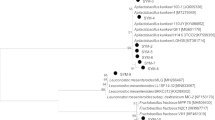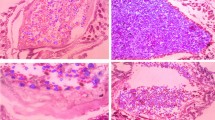Abstract
Microbial symbionts of honeybee colony are considered as promising tools to support the honeybee population welfare. The majority of existing honeybee microbiota studies is focused on genetic description of the honeybee-associated microbiome fingerprints. The lack of a deeper knowledge on the bacterial community colonizing the honeybee niche, which may be helpful in encouraging industrial applications of this microbiota, led us to undertake this study. The biodiversity of the cultivable fructophilic lactic acid bacteria (FLAB) isolated from adult honeybee intestine and beebread samples was studied. Phenotypic properties of probiotic interest, such as the adhesive potential using in vitro models and adhesion determinants, were also investigated. Antibiotic resistance profiles as reliable markers to evaluate the impact of long-term and current exposure of honeybees to antibiotics were phenotypically determined on the isolated lactic acid bacteria (LAB). The mannose-specific adhesion and high cell surface hydrophobicity found in the studied FLAB isolates sheds light on the effective adaptation of microbiota to specific ecologic niche. It is the first report of phenotypically detected antibiotic resistance profiles of honeybee endogenous bacteria and the first account of minimum inhibitory concentration (MIC) values for four antibiotics used in beekeeping practice.


Similar content being viewed by others
References
Becher MA, Osborne JL, Thorbek P, Kennedy PJ, Grimm V (2013) Review: towards a systems approach for understanding honeybee decline: a stocktaking and synthesis of existing models. J Appl Ecol 50:868–880
Bottacini F, Milani C, Turroni F, Sánchez B, Foroni E, Duranti S et al (2012) Bifidobacterium asteroides PRL2011 genome analysis reveals clues for colonization of the insect gut. PLoS One 7:e44229. doi:10.1371/journal.pone.0044229
Carina Audisio M, Torres MJ, Sabaté DC, Ibarguren C, Apella MC (2011) Properties of different lactic acid bacteria isolated from Apis mellifera L. bee-gut. Microbiol Res 166:1–13
Carminati D, Tidona F, Fornasari ME, Rossetti L, Meucci A, Giraffa G (2014) Biotyping of cultivable lactic acid bacteria isolated from donkey milk. Lett Appl Microbiol 59:299–305
Crotti E, Balloi A, Hamdi C, Sansonno L, Marzorati M, Gonella E et al (2012) Microbial symbionts: a resource for the management of insect-related problems. Microb Biotechnol 5:307–317
Duary RK, Rajput YS, Batish VK, Grover S (2011) Assessing the adhesion of putative indigenous probiotic lactobacilli to human colonic epithelial cells. Indian J Med Res 134:664–671
EFSA Panel on Additives and Products or Substances used in Animal Feed (FEEDAP) (2012) Guidance on the assessment of bacterial susceptibility to antimicrobials of human and veterinary importance. EFSA J 10:2740. doi:10.2903/j.efsa.2012.2740
Endo A, Salminen S (2013) Honeybees and beehives are rich sources for fructophilic lactic acid bacteria. Syst Appl Microbiol 36:444–448
Endo A, Futagawa-Endo Y, Dicks LM (2009) Isolation and characterization of fructophilic lactic acid bacteria from fructose-rich niches. Syst Appl Microbiol 32:593–600
Engel P, Martinson VG, Moran NA (2012) Functional diversity within the simple gut microbiota of the honey bee. Proc Natl Acad Sci U S A 109:11002–11007
Evans JD, Armstrong TN (2006) Antagonistic interactions between honey bee bacterial symbionts and implications for disease. BMC Ecol 6:4. doi:10.1186/1472-6785-6-4
Evans JD, Lopez DL (2004) Bacterial probiotics induce an immune response in the honey bee (Hymenoptera: Apidae). J Econ Entomol 97:752–756
Forsgren E, Olofsson TC, Vásquez A, Fries I (2010) Novel lactic acid bacteria inhibiting Paenibacillus larvae in honey bee larvae. Apidologie 41:99–108
Giraffa G, Neviani E (2000) Molecular identification and characterization of food-associated lactobacilli. Ital J Food Sci 12:403–423
Gurgulova K, Panchev I, Stanchev P (2003) A study on antibacterial activity of Riphampizyn against bee disease microorganisms. Uludag Bee J 11:40–41
Huey B, Hall J (1989) Hypervariable DNA fingerprinting in Escherichia coli: minisatellite probe from bacteriophage M13. J Bacteriol 171:2528–2532
Kaufmann A, Kaenzig A (2004) Contamination of honey by the herbicide asulam and its antibacterial active metabolite sulfanilamide. Food Addit Contam 21:564–571
Kim SY, Ogawa Y, Adachi Y (2006) Canine intestinal lactic acid bacteria agglutinated with concanavalin A. J Vet Med Sci 68:1351–1354
Klein AM, Vaissière BE, Cane JH, Steffan-Dewenter I, Cunningham SA, Kremen C et al (2007) Importance of pollinators in changing landscapes for world crops. Proc Biol Sci 274:303–313
Köhler GA, Assefa S, Reid G (2012) Probiotic interference of Lactobacillus rhamnosus GR-1 and Lactobacillus reuteri RC-14 with the opportunistic fungal pathogen Candida albicans. Infect Dis Obstet Gynecol 2012:636474. doi:10.1155/2012/636474
Levy SB, Marshall BM (2013) Honeybees and tetracycline resistance. MBio 4:e00045-13. doi:10.1128/mBio.00045-13
Mercenier A, Lenoir-Wijnkoop I, Sanders ME (2008) Physiological and functional properties of probiotics. Bull Int Dairy Fed 429:2–6
Murray KD, Aronstein KA, Eischen F (2009) Promiscuous DNA and terramycin resistance in American foulbrood bacteria. Am Bee J 149:577–581
Neveling DP, Endo A, Dicks LM (2012) Fructophilic Lactobacillus kunkeei and Lactobacillus brevis isolated from fresh flowers, bees and bee-hives. Curr Microbiol 65:507–515
Olofsson TC, Vásquez A (2008) Detection and identification of a novel lactic acid bacterial flora within the honey stomach of the honeybee Apis mellifera. Curr Microbiol 57:356–363
Ortelli D, Edder P, Corvi C (2004) Analysis of chloramphenicol residues in honey by liquid chromatography–tandem mass spectrometry. Chromatographia 59:61–64
Pilatic H (2012) Pesticides and honey bees. State of the Science. Report from the Pesticide Action Network North America
Potts SG, Biesmeijer JC, Kremen C, Neumann P, Schweiger O, Kunin WE (2010) Global pollinator declines: trends, impacts and drivers. Trends Ecol Evol 25:345–353. doi:10.1016/j.tree.2010.01.007
Reybroeck W, Daeseleire E, De Brabander HF, Herman L (2012) Antimicrobials in beekeeping. Vet Microbiol 158:1–11
Rolfe RD (2000) The role of probiotic cultures in the control of gastrointestinal health. J Nutr 130:396S–402S
Rossetti L, Giraffa G (2005) Rapid identification of dairy lactic acid bacteria by M13-generated, RAPD-PCR fingerprint databases. J Microbiol Methods 63:135–144
Rossetti L, Carminati D, Zago M, Giraffa G (2009) A qualified presumption of safety approach for the safety assessment of Grana Padano whey starters. Int J Food Microbiol 130:70–73
Salminen S, van Loveren H (2012) Probiotics and prebiotics: health claim substantiation. Microb Ecol Health Dis 23:18568
Smodis Skerl MI, Kmecl V, Gregorc A (2010) Exposure to pesticides at sublethal level and their distribution within a honey bee (Apis mellifera) colony. Bull Environ Contam Toxicol 85:125–128
Suárez V, Zago M, Giraffa G, Reinheimer J, Quiberoni A (2009) Evidence for the presence of restriction/modification systems in Lactobacillus delbrueckii. J Dairy Res 76:433–440
Tian B, Fadhil NH, Powell JE, Kwong WK, Moran NA (2012) Long-term exposure to antibiotics has caused accumulation of resistance determinants in the gut microbiota of honeybees. MBio 3:e00377-12. doi:10.1128/mBio.00377-12
Tirado R, Simon G, Johnston P (2013) Bees in decline. A review of factors that put pollinators and agriculture in Europe at risk. Greenpeace Research Laboratories Technical Report (Review)
Vásquez A, Olofsson TC (2009) The lactic acid bacteria involved in the production of bee pollen and bee bread. J Apicult Res 48:189–195
Vásquez A, Forsgren E, Fries I, Paxton RJ, Flaberg E, Szekely L et al (2012) Symbionts as major modulators of insect health: lactic acid bacteria and honeybees. PLoS One 7:e33188. doi:10.1371/journal.pone.0033188
Vauterin L, Vauterin P (1992) Computer-aided objective comparison of electrophoresis patterns for grouping and identification of microorganisms. Eur Microbiol 1:37–41
Vidal JLM, Aguilera-Luiz MDM, Romero-González R, Frenich AG (2009) Multiclass analysis of antibiotic residues in honey by ultraperformance liquid chromatography-tandem mass spectrometry. J Agric Food Chem 57:1760–1767
Vinderola CG, Reinheimer JA (2003) Lactic acid starter and probiotic bacteria: a comparative “in vitro” study of probiotic characteristics and biological barrier resistance. Food Res Int 36:895–904
Vojvodic S, Rehan SM, Anderson KE (2013) Microbial gut diversity of Africanized and European honey bee larval instars. PLoS One 8:e72106. doi:10.1371/journal.pone.0072106
Wu M, Sugimura Y, Taylor D, Yoshiyama M (2013) Honeybee gastrointestinal bacteria for novel and sustainable disease control strategies. J Dev Sust Agric 8:85–90
Yoshiyama M, Wu M, Sugimura Y, Takaya N, Kimoto-Nira H, Suzuki C (2013) Inhibition of Paenibacillus larvae by lactic acid bacteria isolated from fermented materials. J Invertebr Pathol 112:62–67
Zago M, Fornasari ME, Carminati D, Burns P, Suàrez V, Vinderola G et al (2011) Characterization and probiotic potential of Lactobacillus plantarum strains isolated from cheeses. Food Microbiol 28:1033–1040
Acknowledgments
The author I.J. would like to express his gratitude to the Shota Rustaveli National Science Foundation (SRNSF) for partial support allowing his PhD training in Italy. The author also expresses his gratitude to the Service of Science and Technology of the French Embassy in Tbilisi for the fellowship allowing his PhD training in France.
Author information
Authors and Affiliations
Corresponding author
Electronic supplementary material
Below is the link to the electronic supplementary material.
ESM 1
(PDF 71 kb)
Rights and permissions
About this article
Cite this article
Janashia, I., Carminati, D., Rossetti, L. et al. Characterization of fructophilic lactic microbiota of Apis mellifera from the Caucasus Mountains. Ann Microbiol 66, 1387–1395 (2016). https://doi.org/10.1007/s13213-016-1226-2
Received:
Accepted:
Published:
Issue Date:
DOI: https://doi.org/10.1007/s13213-016-1226-2




